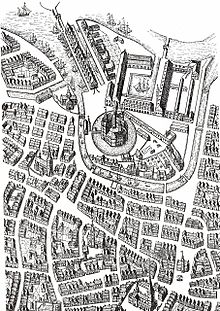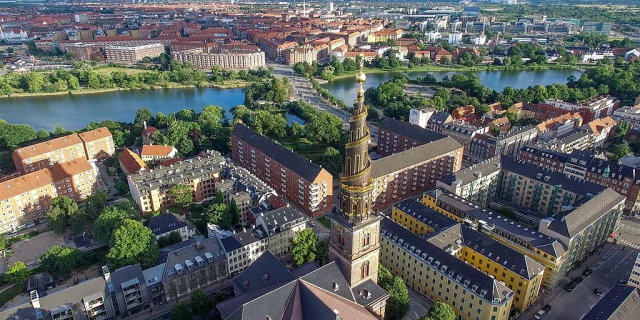Slotsholmen (English: The Castle Islet) is an island in the harbour of Copenhagen, Denmark, and part of Copenhagen Inner City. The name is taken from the successive castles and palaces located on the island since Bishop Absalon constructed the city's first castle on the island in 1167 at the site where Christiansborg Palace lies today.
Recognised as the centre of the Government of Denmark since the Middle Ages, the island is sometimes referred to as 'the Island of Power' (Magtens Ø), and is lined with central government institutions and ministries; the name Slotsholmen is thus also frequently used as a metonym for overall Danish governmental administration.
The island is dominated by the vast Christiansborg Palace which houses the Danish Parliament, the Supreme Court of Denmark, the Prime Minister's Office and the State Rooms of the Queen. Also located on the island are the most important ministries, the Danish National Archives, the Royal Danish L...Read more
Slotsholmen (English: The Castle Islet) is an island in the harbour of Copenhagen, Denmark, and part of Copenhagen Inner City. The name is taken from the successive castles and palaces located on the island since Bishop Absalon constructed the city's first castle on the island in 1167 at the site where Christiansborg Palace lies today.
Recognised as the centre of the Government of Denmark since the Middle Ages, the island is sometimes referred to as 'the Island of Power' (Magtens Ø), and is lined with central government institutions and ministries; the name Slotsholmen is thus also frequently used as a metonym for overall Danish governmental administration.
The island is dominated by the vast Christiansborg Palace which houses the Danish Parliament, the Supreme Court of Denmark, the Prime Minister's Office and the State Rooms of the Queen. Also located on the island are the most important ministries, the Danish National Archives, the Royal Danish Library, several museums and the historic buildings of the Christian IV's Stock Exchange, the Chancellery and Christian IV's Brewhouse.
The population number was 18 people as of 1 January 2020.
 Slotsholmen in 1674 with Copenhagen Castle, Børsen and Christian IV's Naval Harbour
Slotsholmen in 1674 with Copenhagen Castle, Børsen and Christian IV's Naval HarbourThe site used to consist of several small natural islands in the sound between the islands of Zealand and Amager. On the largest of these, Strandholmen (English: Beach Islet), Bishop Absalon of Roskilde constructed a small castle in 1167. In 1250 the castle was extended with two side towers to get the appearance that is now depicted on Copenhagen's Coat of Arms. The castle was conquered by the Hanseatic League 1368 and pulled down the following year as part of peace terms. Shortly after Copenhagen Castle was built on the same site and it became the residence for the Danish king in 1443.
After the 1535-36 siege of Copenhagen during the Count's Feud, it became clear that the castle was outdated as a military installation, and King Christian III transformed the castle from a military stronghold to a more liveable royal residence. However, the reconstruction took place in a rather haphazard way and continued during the reign of the following kings, resulting in a rather irregular appearance of the castle.
At the same time, it became clear that the castle was becoming too small to hold the functions necessary in order to function as a royal residence and seat of the administration so a series of smaller buildings began to be erected on Slotsholmen. Probably during the reign of Christian III a building was constructed on the quay of the canal in front of the castle to house the Chancellery. During the reign of Christian III and Frederick II an arsenal was constructed by the beach south of the castle, and during the reign of Frederick II probably also a supply depot.
 Slotsholmen from the south with Frederiksholms Canal to the left and the entrance to Christian IV's Naval Harbour in the middle (1750)
Slotsholmen from the south with Frederiksholms Canal to the left and the entrance to Christian IV's Naval Harbour in the middle (1750)Under King Christian IV Slotsholmen saw considerable development, especially in the southern part of the island. Here a new naval harbour was established, surrounded on one side by an Arsenal and on the other side by a Supply Depot. Other new buildings constructed were the Stock Exchange and the Brewhouse. All four of these historic buildings are still there today.
By the time of the introduction of the absolute monarchy in 1660, the role of Slotsholmen as the centre of administration was firmly established.
During the reign of King Frederick III, further lack of space in the castle led to the construction in 1665-1673 of an additional building between the Supply Depot and the Arsenal. This building, also still visible today, was to house the Cabinet of curiosities of the king, founded about 1650, and the Royal Library, founded in 1648.
 The rebuilt Copenhagen Castle about 1730 with the new Chancellery building to the left and the passageway linking the two buildings
The rebuilt Copenhagen Castle about 1730 with the new Chancellery building to the left and the passageway linking the two buildingsDuring the reign of King Frederick IV, a magnificent administration building was constructed in 1716-21 next to the palace adjacent to the Supply Depot. This new building was to house the chancelleries, thus replacing the previous chancellery building situated by the canal. The new chancellery building was connected to the castle by an arched passageway, thus allowing the king to stay in close contact with his government. The Chancellery Building (also known as the Red Building or the Building of Colleges) has functioned as the heart of the central administration for almost 300 years, and is today used by the Ministry of Finance.
In spite of many attempts and projects to replace the small and antiquated castle with a more up-to-date royal residence fit for an absolute king, the old castle continued to exist well into the 18th century. Several renovations were made, most notably by Frederick IV in 1721-29. This rebuilding thoroughly changed the irregular appearance of the castle to a more regular shape.
 The first Christiansborg Palace, engraved illustration in Lauritz de Thurahs Den Danske Vitruvius from 1746
The first Christiansborg Palace, engraved illustration in Lauritz de Thurahs Den Danske Vitruvius from 1746However, just two years after the rebuilding was completed, the Copenhagen Castle was demolished in 1731 to give room for three consecutive Christiansborg Palaces, the two first of which were destroyed by fires (in 1794 and 1884). Parts of the first and second Christianborg Palace still remain and is integrated in the present palace. The ruins of Absalon's Castle and the Copenhagen Castle are excavated and at display today under the present Christiansborg.




































Add new comment